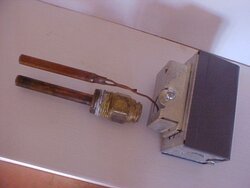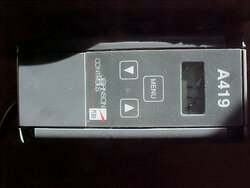I have some questions about aquastat installation and selection perhaps some of you may know the answers to. Here's is what I do and don't know about them, and what I need to accomplish. I know aquastats act like switches for 24 volt circuits, are used with relays sometimes for higher voltages, can be single, double, and triple pole, and can turn on and off circs. I think you can get them as either well mounted or pipe strap ons. Please correct me if I'm wrong.
I am trying to do something simple. This to have one aquastat turn on or off the two circulation pumps servicing either side of my DHW flat plate, and at the same time tell a motorized ball valve to open. (That ball valve allows water to flow to the line servicing either or both the W/A HX or the DHW flat plate HX). I think I would prefer a well type aquastat as they are more accurate.
What I dont know is:
1. How do you set on the aquastat the temperature you want to turn on and off on, or do you buy one that has the temps you want preset.
2. I am not sure what a well looks like or how it would fit into the pipe. The Honeywell aquastats I looked at on the PexSupply site looked like they have real long tubes connected to them. I can't picture how they'd fit into a pipe. How do you plumb them in? I thought maybe you'd put a tee into the pipe where you wanted to gather the temperature reading, and tighten the well into the tee and put some transfer medium into the well that holds the temperature probe of the aquastat. Never having done this, I just don't know. Can't remember the name of the transfer paste either. It was a short word. What and what size fittings would the well normally go in to?
3. I am placing the aquastat into the pipe going to the DHW side of the flat plate hx. That flat plate is being added on a new pipe connecting between where the drain and pressure relief valve currently are on my propane fired water DHW heater. I think I read in a previous post, which I can't yet locate, the aquastat should go towards the bottom fitting of the tank. Is that correct? I will tee off the drain and pressure relief valve on this line when I make the change.
4. . What lower and upper temperatures should the aquastat be set or preset to? I remember, I think, HR saying, you can get up to and maintain 160 degrees in the tank with a tempering (mixing) valve in place. I have purchased a tempering valve to moderate the hot water output of the tank. Would 160 degrees be the top setting for the aquastat then? I would think that makes sense. What should the lower setting be?
5. I read terms like "break on rise" and don't know what they mean. I dont know how these aquastats or their wells physically fit into a pipe, or how to select the one needed from all those available, and there are lots. I've got an idea on how they function electrically from reading the "Quick and Basic Hydronics Controls" book by Carol Fey, purchased off Dan Holohan's site, but not the physical installation.
If anyone can explain the selection and physical installation of one of these in a "Volkswagen Repair for Dummies" manner I'd be beholden. The pumps I'm turning on or off are a Grundfos 15-58 on low speed (24volt) and a Laing low-flow recirculation pump (115volt). The Honeywell motorized ball valve is 24 volt. What would you recommend as a good aquastat (and relay if necessary) for this application and how do I select between them? Meanwhile I'll keep searching for the relevant previous posts. Thanks.
I am trying to do something simple. This to have one aquastat turn on or off the two circulation pumps servicing either side of my DHW flat plate, and at the same time tell a motorized ball valve to open. (That ball valve allows water to flow to the line servicing either or both the W/A HX or the DHW flat plate HX). I think I would prefer a well type aquastat as they are more accurate.
What I dont know is:
1. How do you set on the aquastat the temperature you want to turn on and off on, or do you buy one that has the temps you want preset.
2. I am not sure what a well looks like or how it would fit into the pipe. The Honeywell aquastats I looked at on the PexSupply site looked like they have real long tubes connected to them. I can't picture how they'd fit into a pipe. How do you plumb them in? I thought maybe you'd put a tee into the pipe where you wanted to gather the temperature reading, and tighten the well into the tee and put some transfer medium into the well that holds the temperature probe of the aquastat. Never having done this, I just don't know. Can't remember the name of the transfer paste either. It was a short word. What and what size fittings would the well normally go in to?
3. I am placing the aquastat into the pipe going to the DHW side of the flat plate hx. That flat plate is being added on a new pipe connecting between where the drain and pressure relief valve currently are on my propane fired water DHW heater. I think I read in a previous post, which I can't yet locate, the aquastat should go towards the bottom fitting of the tank. Is that correct? I will tee off the drain and pressure relief valve on this line when I make the change.
4. . What lower and upper temperatures should the aquastat be set or preset to? I remember, I think, HR saying, you can get up to and maintain 160 degrees in the tank with a tempering (mixing) valve in place. I have purchased a tempering valve to moderate the hot water output of the tank. Would 160 degrees be the top setting for the aquastat then? I would think that makes sense. What should the lower setting be?
5. I read terms like "break on rise" and don't know what they mean. I dont know how these aquastats or their wells physically fit into a pipe, or how to select the one needed from all those available, and there are lots. I've got an idea on how they function electrically from reading the "Quick and Basic Hydronics Controls" book by Carol Fey, purchased off Dan Holohan's site, but not the physical installation.
If anyone can explain the selection and physical installation of one of these in a "Volkswagen Repair for Dummies" manner I'd be beholden. The pumps I'm turning on or off are a Grundfos 15-58 on low speed (24volt) and a Laing low-flow recirculation pump (115volt). The Honeywell motorized ball valve is 24 volt. What would you recommend as a good aquastat (and relay if necessary) for this application and how do I select between them? Meanwhile I'll keep searching for the relevant previous posts. Thanks.


 Cap tubes are nice for overheat, of back up system controls.
Cap tubes are nice for overheat, of back up system controls.
